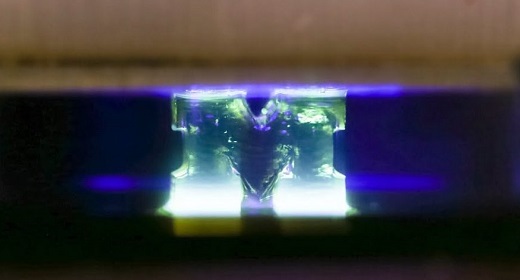by Luke Dormehl: Are you old enough to remember the speed increase when you jumped from a dot matrix printer to a laser printer for the first time?
How about when you switched from dial-up internet to broadband? 3D printing could be about to get a similarly seismic speed boost, thanks to pioneering research coming out of the University of Michigan.
Researchers there have invented a new method of 3D printing that is up to 100 times faster than conventional 3D-printing processes. This could potentially prove transformative for the use of additive manufacturing in large-scale print runs, as opposed to one-off prototypes.
“We demonstrated the ability to harden liquid resin with one wavelength of light while preventing the hardening of the resin by superimposing light of a different wavelength,” Timothy Scott, an associate professor of chemical engineering at the University of Michigan, told Digital Trends.
The researchers’ approach to 3D printing is a variation on the conventional method of stereolithography (SLA). This 3D-printing method involves projecting a two-dimensional image is projected onto photoreactive liquid resin to make a defined solid layer. These can then be stacked up to create a three-dimensional object. Unfortunately, in the words of the researchers, SLA can be “painfully slow” when it comes to printing. This is due to a separation and refilling step that accompanies the curing of each layer.
In the new approach, however, the researchers have figured out how to use two lights to control where the resin hardens and where it stays fluid. This allows for the solidification of resins into more complex patterns — including making a 3D sculpture in just one single shot, rather than as a series of 2D cross-sectional layers.
“[To address this limitation,] we applied our dual-wavelength approach where one light beam was used to prevent the resin solidifying onto the projection window, while the second light beam can penetrate deeper into the liquid and solidifies the resin away from the window [where the light enters],” Mark Burns, the T.C. Chang Professor of Engineering at the University of Michigan, told us. “This process leaves liquid in the gap between the solidified part and the projection window and eliminates the need for the time-consuming separation and refilling step, thus enabling continuous printing at very high speeds.”
Scott said that the next step in the research is to expand the resin palette to include different chemistries and improved mechanical and thermal properties to build a full-scale, high-resolution prototype printer. “I think the likelihood of commercialization is very high,” he said. It’s so high, in fact, that the researchers are currently in the process of establishing a startup based on the technology.
















































